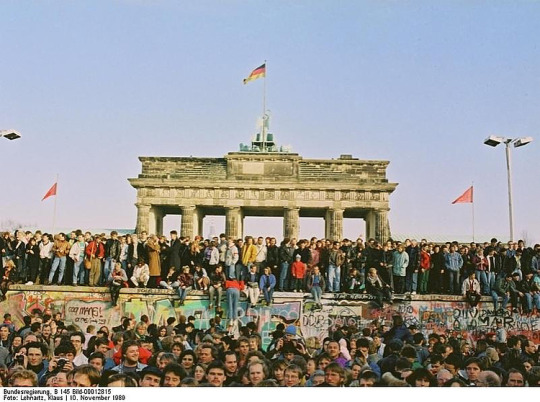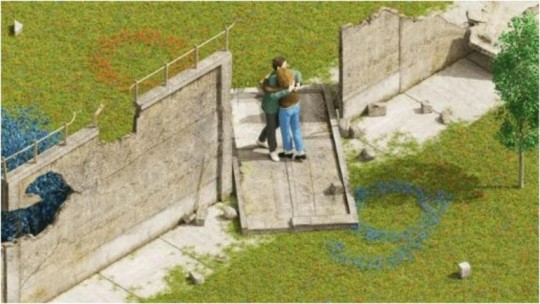#FallOfBerlinWall
Explore tagged Tumblr posts
Text
youtube
🎥 WarTalesVault presents: The Fall of Berlin 1945 — Watch History Collapse in Real Time 🎥 Witness the dramatic and brutal conclusion to World War II as you dive deep into the Battle of Berlin, the final, bloody confrontation that sealed the fate of Nazi Germany. In Berlin 1945, devastation reigned supreme — from the crumbling streets to the broken spirit of a fallen empire.
#WarTalesVault#BattleOfBerlin#Berlin1945#FallOfBerlin#TheFallOfBerlin#FallOfBerlinWall#BerlinWallFalls#TheFallOfGermany1945#LifeInBerlin1945#WomenBerlin1945#SchlachtUmBerlin1945#BatallaPorBerlin#AdolfHitler#WW2History#FallOfBerlinEdit#Berlin1945WW2#TheFallOfBerlinFilm1945#TheFallOfBerlinWatchOnline#HistoryCollapse#WW2Documentary#Youtube
0 notes
Text

#FallOfBerlinWall#Caduta Del Muro Di Berlino#Fall Der Berliner Mauer#Chute Du Mur De Berlin#배를린 장벽 붕괴#Never Forget#Mai Dimenticare#Nie Vergessen#N’Oubliez Jamais#절대잊지마세요#History#Storia#Geschichte#Histoire#역사
1 note
·
View note
Text
The Fall of the Berlin Wall: Ending the Cold War
The year was 1989, and the world was on the brink of a momentous change. On November 8, a date forever etched in history, the Berlin Wall came down, ushering in a new era and marking the beginning of the end of the Cold War. This event would not only transform Germany but would have far-reaching implications for the entire world. In this article, we delve into the significance of the Berlin…

View On WordPress
0 notes
Photo

Crafting with op shop materials... Just noticed this cotton is older than I am! It was made before the fall of the Berlin Wall! #vintagecrafts #vintagecrotchet #crotchet #crotchetjewelry #fallofberlinwall #etsyaustralia #etsystoreowner #etsyhandknit #etsyjewelry #handmadeinaustralia #handmadecanberra #handmadeincanberra #handmadebycatkin #handmadeisbetter #historicaljewellery #historicalfashion #etsystore #etsy https://www.instagram.com/p/CV9QpLZBsc5/?utm_medium=tumblr
#vintagecrafts#vintagecrotchet#crotchet#crotchetjewelry#fallofberlinwall#etsyaustralia#etsystoreowner#etsyhandknit#etsyjewelry#handmadeinaustralia#handmadecanberra#handmadeincanberra#handmadebycatkin#handmadeisbetter#historicaljewellery#historicalfashion#etsystore#etsy
0 notes
Text
30 साल पहले क्यों गिराई गई थी बर्लिन की दीवार? जानें जर्मनी के इतिहास में क्यों है यह खास

चैतन्य भारत न्यूज 09 नवंबर 1989 के दिन बर्लिन की दीवार गिरा दी गई थी। ये जर्मनी ही नहीं दुनियाभर के लिए एक ऐतिहासिक दिन था। गूगल ने इसकी याद में आज एक खास गूगल डूडल बनाया है। इस दीवार ने 28 सालों तक बर्लिन शहर को पश्चिम और पूर्व में बांटा था। इसे गिरे अब तीस साल बीत चुके हैं। बर्लिन शहर को दो हिस्सों में बांटने वाली दीवार 13 अगस्त 1961 को खड़ी की गई थी। (adsbygoogle = window.adsbygoogle || ).push({});

दरअसल दूसरे विश्व युद्ध के बाद जर्मनी दो देशों में बंट गया था, तो सैंकड़ों कारीगर और व्यवसायी प्रतिदिन पूर्वी बर्लिन को छोड़कर पश्चिमी बर्लिन जाने लगे। बहुत से लोग राजनीतिक कारणों से भी समाजवादी पूर्वी जर्मनी को छोड़कर पूंजीवादी पश्चिमी जर्मनी जाने लगे। इससे पूर्वी जर्मनी को आर्थिक और राजनीतिक रूप से बहुत हानि होने लगी।

बर्लिन दीवार का उद्देश्य इसी प्रवासन को रोकना था। इस दीवार के विचार की कल्पना वाल्��र उल्ब्रिख्त के प्रशासन ने की और सोवियत नेता निकिता ख्रुश्चेव ने इसे मंजूरी दी। हालांकि इस दीवार का बनना समाजवादी गुट के प्रचार तंत्र के लिए बहुत बुरा साबित हुआ। पश्चिम के लोगों के लिए यह समाजवादी अत्याचार का प्रतीक बन गई, खास तौर पर जब बहुत से लोगों को सीमा पार करते हुए गोली मार दी गई। बहुत से लोगों ने सीमा पार करने के अनोखे तरीके खोजे। इसमें सुरंग, गरम हवा के गुब्बारे, दीवार के ऊपर गुजरती तारों पर खिसकना शामिल था।

जब लोगों ने इस दीवार को तोड़ा तो इसके टुकड़े याद के तौर पर ले आए। बर्लिन दीवार के गिरने से पूरे जर्मनी में नए राष्ट्रवाद का उदय हुआ। इसके परिणामस्वरूप पूर्वी जर्मनी के लोगों ने जर्मनी के साथ एकीकरण पर मंजूरी दी और 3 अक्टूबर 1990 को जर्मनी फिर एक देश बन गया।

Read the full article
#2ndworldwar#2ndworldwargermany#FallofBerlinwall#germany#germanyberlinwall#historyofberlinwall#wallofberlin#whyBerlinWallfall#कबगिराईगईबर्लिनकीदीवार#जर्मनी#बर्लिन#बर्लिनकीदीवार#बर्लिनकीदीवारकाइतिहास#बर्लिनकीदीवारगिरानेकामकसद#बर्लिनदीवार#बर्लिनदीवारगूगलडूडल
0 notes
Photo

#budapest #wall #berlinerwall #oppression #fallofberlinwall #freedom #hungary #hungary_gram #hungarygram (presso Budapest, Hungary) https://www.instagram.com/p/B3St06YHLJJ/?igshid=14fv70ilber5c
0 notes
Video
youtube
World Freedom Day Beaufort County SC Bluffton & Beyond
#youtube#WorldFreedomDay BeaufortCounty SC Bluffton & Beyond JasperCounty federalobservance endofcommunistrule fallofBerlinWall
0 notes
Text
25 Years Later: The Fall of the Berlin Wall

The UWM German program is holding this event to commemorate the anniversary of the fall of the Berlin Wall. They offer an evening dedicated to the event’s history and continuing significance. In addition to a documentary film on the history of the Berlin wall, the evening’s program will feature panel of speakers who will share both personal and professional perspectives on the wall. Two speakers (Eveline Kehlert and Fabian Klein) will share their lived experience, while two others (Dr. Winson Chu and Sigurd Piwek) will discuss the wall’s significance from historical and pedagogical perspectives. The event is on Sunday, November 9, in Curtin 175, at 6 p.m.; it is free and open to the public.
1 note
·
View note
Text
Legacy of Berlin Wall - Interviews
Could you describe examples of how the Wall, and what it represented, influenced German cultural and aesthetic works created during its existence?
JS: East Germany had a vibrant literary culture and produced a great many novels that reflect the experience of the Wall. I especially admire Christa Wolf's Divided Heaven. Her career illustrates both the accomplishments and the limitations of culture in a society like the GDR. Since 1989, there has been a great deal of work reflecting on the meaning of the Wall. I just read Uwe Tellkamp's novel, Der Turm, which is set in and around Dresden in the late 1980s. It is a remarkable book in many ways, a sprawling family saga as well as a sharp political portrait of the regime's last days.
AE: The Wall played a crucial role in the writing of such significant writers as Christa Wolf (of the former GDR) and Peter Schneider (of the Federal Republic of Germany). In novels such as Divided Heaven (1963), Wolf gave us a lasting image of life in the shadow of the Wall. In The Wall Jumper, Schneider made the absurdity of an edifice such as the Wall painfully tangible. Yet, a novel like Ian McEwan’s The Innocent makes it clear that the Wall and the division of Germany also left a significant mark on European literature as such. In recent years, films like "The Lives of Others" began exploring the meaning of the East-West divide and the lasting impact of European totalitarian regimes on the lives of individuals and societies.
During the course of your work what kind of evidence have you encountered that illustrates how the Wall impacted the legacy of European Jews?
JS: East and West Germany dealt with the legacy of Nazism--and the meaning of the Holocaust--in quite different ways. In the GDR, Nazism was seen as a particularly toxic form of fascism, that is, an expression of capitalism's structural crisis. From this perspective, the racial dimensions of Nazism did not seem central: there was, for instance, very little about the Holocaust in the exhibitions on Nazism in the old East German museum of German History. Like the museum itself, this view of Nazism is now largely gone.
AE: The Jewish community of both the GDR and the Federal Republic was rather small when the Wall was built. While the Federal Republic accepted early on the German responsibility for Nazism, the GDR regarded itself as representing the legacy of the ‘better Germany’ that is of the German left. This has been as many scholars have since claimed, the foundational myth of the GDR. In the decades following the building of the Wall, the issue for German-Jewish relations was less the East-West divide and more finding ways to commemorate the dead of the Holocaust, acknowledging the crimes of the Nazis and developing a German-Jewish dialogue based on mutual respect and different memories. However, one of the most significant contemporary German-Jewish authors is Barbara Honigmann, who in her writing also reflects on what it meant for her and others like her to grow up and come to age as a Jew in the GDR.
From the perspective of your research, what do you feel are the most lasting implications of the Berlin Wall today?
JS: In the euphoric days after the fall of the Wall, many people underestimated the material and spiritual difficulties of unification. It is not surprising that, after 40 years apart, the two Germanies have only slowly grown together. Like parts of the American south after the Civil War, parts of the old GDR have a nostalgic view of the "good old days" before 1989. This has an impact on German culture, especially in Berlin. A more lasting implication is the Left Party, a somewhat improbable alliance of Western German leftwing Social Democrats and the former East German Party of Democratic Socialism.
AE: The Wall will always remain a symbol of tyranny. It will also continue to remind us what fantasies about a ‘perfect’ human society such as those that guided the Soviet Union and the GDR may end up producing: endless human misery and the creation of enclosed, repressive political systems.
Do you believe there’s still more to learn from this transformative period of history?
JS: Historians always believe there is more to learn. In the case of 1989, I think one lesson is how often history surprises us. No one expected the Wall to fall so suddenly and so peacefully, just as no one expected the Soviet Union to collapse with such speed. Nor has the post-Cold War world turned out quite the way many people expected.
AE: Absolutely. The learning about the nature and the challenges of totalitarian thought and totalitarian regimes has just begun. Contemporary totalitarian regimes across the globe such as Iran, Syria, Myanmar or North Korea make the study of the Wall and how we—those living in open societies may react to them—crucial for the freedom of millions who suffer by those regimes. The study of the Wall and of such regimes may also prove crucial for our survival given the fact that these regimes strive to acquire deadly military capacities.
0 notes
Text
Tearing Down The Wall
“East German’s Great Awakening,” The New York Times, November 10, 1989, 36.
“Physically the Berlin wall still stands. But its capacity to divide a country and a Continent seems at an end. East Germany’s hastily reshaped politburo now promises its people what even two weeks ago was still unthinkable: unrestricted travel to the West; free elections; market-oriented economic reforms. Deathbed conversions are always suspect. But what Marxists call objective realities suggest this great awakening will endure.”
“Cheers as Brandenburg Gate Reopens,” The New York Times, December 23, 1989, 7.
“Leaders of the two Germanys reopened the Brandenburg Gate today, breaching a barrier that more than any other had come to symbolize the division of the nation. Tens of thousands of Germans, oblivious to a steady drizzle, packed both sides of Berlin’s most famous gate to celebrate the formal inauguration of two new pedestrian crossings. . . . Although it has been six weeks since the Berlin wall fell open and at least half the East Germans have visited the West, the reopening of the two-century-old landmark offered symbolic confirmation that the German nation was again seeking to become whole.”
“Final Month of Berlin Wall,” The New York Times, June 16, 1990, 4.
“East Germany has set a deadline of December for total demolition of the Berlin wall, which sealed citizens off from the West for 28 years. The state press agency quoted Maj. Gen. Dieter Teichmann, chief of the border troops, as saying that the concrete barrier would be gone by December. On Wednesday, East Germans began knocking out wall slabs all over the city to reopen blocked streets.”
Question: How do these articles document the historical significance of the Berlin Wall and its demise?
0 notes
Text
Berlin's Spatial Paradox
Walls between people are made to be destroyed. The Berlin Wall, which for thirty years prevented free migration from East Germany, was no different. Nonetheless, the wall has left an architectural, economic and behavioural legacy on the Berlin landscape. The wall’s spatial heritage continues to influence the city. Despite the millions of Euros that flooded into the city since 1989 to help reunify Germany and its role as Germany’s capital, Berlin remains a city deeply affected by the moral and physical scars left by the wall. Reunification did not perform miracles. The eastern part of the city continues to be challenged by the Soviet legacy. Berlin is only now in the process of becoming a significant metropole. Its socio-spatial distortions – mostly caused by the wall – have prevented its growth and development. One opportunity for Berlin to overcome these obstacles, however, is in the eastern growth of the European Union. Eastern expansion would draw Berlin from the outskirts into an enviable position within Europe.
This is Berlin’s spatial paradox. The city’s external geopolitical role is gradually increasing as Germany’s international reputation balances with its economic weight. Over the past decade this change has been made manifest through the ‘five plus one’ meetings between Germany and the members with veto power from the UN Security Council, as well as through German participation in international military operations. Internally, however, the wall’s effects on the city’s spatial politics have been much less beneficial. In comparison with similar German cities like Frankfurt and Munich, Berlin’s economic and demographic success has been much more limited. Even though the wall is gone, the city continues a somewhat paradoxical existence.
0 notes
Text
Is the Berlin Wall still present?
With the exception of six conserved sections and brass plaques marking the wall’s location, the physical wall – and the formal division between East and West Berlin – has disappeared. Replacing this division was a new political space.
It is not difficult, however, for the attentive observer to notice that a geopolitical wall continues to divide the city. In the West, the scars of the Second World War, symbolized by the bombed-out Kaiser Wilhelm Memorial Church and the more recently reconstructed Reichstag – with its glass dome symbolizing transparent democracy, serve as a continual reminder of the stain of Nazism on German history. In the East, little trace remains of the Nazi influence, even though the past is now somewhat recalled in the recently rebuilt Rykestrasse synagogue in the city’s Jewish quarter.
The two sides of the city also have different architecture. The West, which was about five times the size of Paris, had less population pressure than East Berlin. This large amount of space meant that high rises were practically nonexistent across its 484 km2 territory. The East, on-the-other-hand, sought to demonstrate its ‘modernity’ by transforming the Alexanderplatz with structures like the Fernsehturm and building layers of similar looking suburbs in the city’s outlaying areas.
The socialist influence also continues to divide the East from West. Statues of Marx and Lenin and images of the hammer and sickle can still be found in old East Berlin. Traces of the GDR also remain in the debate over the rebuilding of the imperial palace, which was destroyed in 1950 to create the soulless Palace of the Republic and Marx-Engels Square. Whether this plan will move forward is still a question remaining for a city with limited financial resources.
The Wall itself remains a scar on the city’s human and economic landscape. Before the Second World War, Berlin was the largest, most innovative and industrialized city in Germany. After 1945, West Berlin’s unique situation (it was inaccessible, in a poor position relative to suppliers and markets, and deeply affected by the departure of workers) reined its economy in. It was a gloomy situation: for the most part West Berlin relied on the aid and protection of its Western occupiers. In East Berlin, the socialist planned economy, with its emphasis on large state-run businesses, created deficiencies in the organization and profitability of the economy. Since 1990 Berlin has benefited from the return of the national government, many renowned institutions and important head offices, and an increase in tourism.
The tearing down of the Berlin Wall expanded the free space accessible to West Berliners. Many moved outside of the city and into areas formerly controlled by the GDR. Like when the wall first went up, this out-migration – along with a weak birth rate – caused the population to decline.
In many ways Germany continues to be a divided country. Although the wall has been removed, the division continues to be seen through differences in birth rates, migration patterns, age structures and the economy.
0 notes
Text
Fall of the Berlin Wall
For more than 28 years, the Berlin wall was a major symbol of both the Cold War and the oppressive Soviet regime, but it became obsolete in 1989 when Hungary opened its borders to East Germans. With Hungary open, emigrants could pass through to West Germany with little difficulty. In a desperate last attempt to restore stability, the East German leader Egon Krenz decided to grant passage through the Berlin Wall itself. On November 9, 1989, East Germans poured into West Germany, partially destroying the wall on the way, while communist officials watched their regime crumble. In West Germany, the immigrants were welcomed with a gift of 100 marks ($50), as their East German money had become worthless. East and West Germany then worked together to remove the wall and reunite themselves as the Federal Republic of Germany in 1990.
The fall of the Berlin Wall was a major turning point in recent history. It marked the end of communism in Germany, and was a symbol for the end of communism throughout Europe. Soon after the collapse of the German regime, communist governments began to fall in other nations such as Poland, Romania and Czechoslovakia. In 1991, after a failed coup by Soviet leaders against President Mikhail Gorbachev, the Soviet Union itself dissolved, completely ending the reign of oppression that had begun in 1917. Many European countries that were under Soviet control broke out in civil war, and the former members of the U.S.S.R. became 15 independent republics and formed the Commonwealth of Independent States (CIS).
0 notes